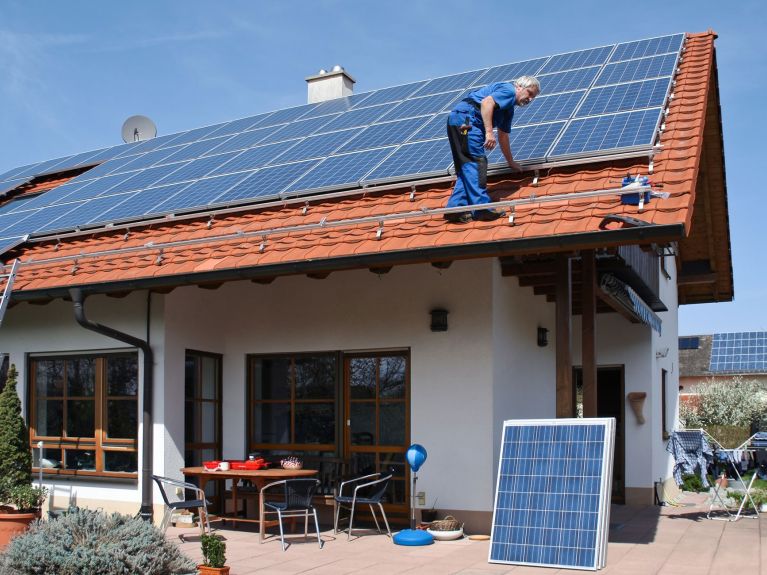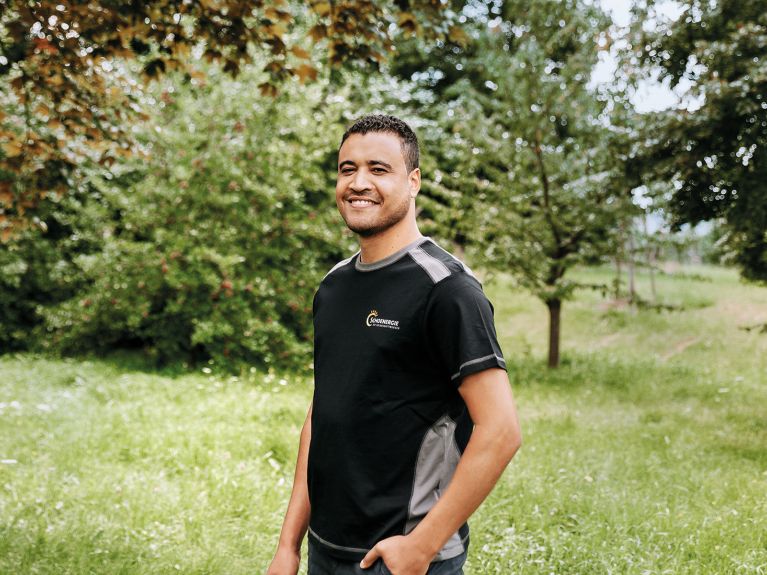Working together on the energy transition
Demand is higher than ever for international skilled workers to fill the growing number of “green jobs” in Germany.

If someone asked you to imagine the energy transition, you’d probably think of wind turbines and solar panels. But for Constantin Eis, skilled workers come to mind. Constantin Eis runs the green energy supplier Lichtblick. He wrote an open letter to Robert Habeck, the Federal Minister for Economic Affairs and Climate Action. “No extra pairs of hands, no transition” was the title of the letter. The signatories to the letter included managers of businesses like 1Komma5°, Thermondo, PowerUs and Installion. They are calling for nothing less than “turbocharging skilled workers” in order to accelerate the energy transition. Their proposals range from speeding up the qualification process for solar panel installers, to making it easier for skilled workers to migrate to Germany.
Having enough qualified staff is critical to making the most of the enormous potential of climate protection technologies.
The letter from the energy sector is not only a sign of importance of the issue, but it also demonstrates how businesses are willing to break new ground. Eis justifies his initiative with the argument that “The shortage of skilled workers is currently one of the biggest challenges to climate protection.” But the Lichtblick boss and his fellow campaigners aren’t just making a series of demands. They have a proposal to make, too. “In our letter we wanted to support government initiatives to deal with the shortage of skilled workers and signal our readiness to deliver solutions quickly with all involved,” Eis says. “Having enough qualified staff is critical to making the most of the huge potential of climate protection technologies,” he adds.
That potential really is enormous. Climate-friendly technologies are enjoying a boom all over the world, according to a recent report by the International Energy Agency IEA, which records record highs in 2022 for the expansion of renewable energy, including a 26% growth in solar panels. Investment in clean energy rose by 15% and is worth $1.6 billion. Sales of electric cars also rose sharply, more than trebling their market share within two years. The trends are so dynamic that the IEA’s conclusions are positive, even where international climate action is concerned. “Rapid progress of key clean energy technologies shows the new energy economy is emerging faster than many think,” they say.
In Germany, too, demand for solar panels, electric cars and heat pumps is higher than ever. Interest in energy transition technologies is rising, both in business and the general public, according to a study by Agora Energiewende. The charitable thinktank analyses progress in transforming energy and industrial systems, and also surveys the public on their attitudes to the issue. Their conclusion? “The topic of the energy transition is firmly embedded in the minds of the general public.” When energy prices spiked in 2022 due to the war in Ukraine, climate and environmental protection were always among the most pressing issues for
people in Germany. The thinktank argues there is “broad social backing for the energy transition.”
In the ten years after 2000, the proportion of green electricity in Germany’s supply rose from 6% to three times that level.
You might say Germany is the birthplace of the energy transition – after all, this is where the term was “invented”. The German word “Energiewende” combines two previously unconnected ideas to create something new, a memorable way of describing the transformation of our energy supplies, leaving behind fossil fuels in favour of renewable energy. The term attracted attention around the world and found a place in a number of languages, and even English, where “Energiewende” is sometimes used in scientific publications. Now similar terms exist for other fields relevant to climate protection such as transport (“Verkehrswende”), heating (“Wärmewende”), and farming (“Agrarwende”).
“Energiewende” first emerged in Germany in the late 1970s. The anti-nuclear movement were the first to call for the restructuring of the energy systems, demanding a “transition” to new forms of energy. On the one hand they were calling for an end to nuclear power, which at the time played a major role in Germany. On the other hand, their demands also included using energy more economically and reducing dependence on imported fuel, especially oil.
At around the same time, a new Öko-Institut was set up in Freiburg to focus on environmental issues. It also emerged from the anti-nuclear movement and is now a leading environmental research institution. In 1980 the new institute published a report with the forward-looking title of “Energy Transition: growth and prosperity without oil and uranium”. The key points of the report were that wind power, solar power, hydropower, biomass and geothermal energy should replace fossil fuels, accompanied by energy efficiency as an additional measure. Florentin Krause, one of the authors of the report, once described energy efficiency as “the trump card if you want to make climate goals safe and affordable.” Today, these are the key elements of Germany’s energy transition policy.
But there was still a long way to go to get from calls and concepts to the point of concrete policies. Committees advising the Federal Government warned of the risks of climate change, while a 1987 inquiry into provisions to protect the earth's atmosphere recommended substantial cuts to greenhouse emissions. Shortly before this, the “Spiegel” current affairs magazine prompted a public debate on the issue through its headline story entitled “The Climate Catastrophe”.
By passing the Renewable Energy Sources Act in 2000 the Federal Government created a principle where green electricity was given priority, along with increasing subsidies. The improved conditions made it more attractive for many businesses and members of the public to invest in the energy transition. Soon, wind turbines and solar panels could be seen across the whole country. In the ten years after 2000, the proportion of green electricity in Germany’s supply rose from 6% to three times that level. Today, it is just under 50%. Speeding up the expansion of green energy quickly reduced prices for what had initially been expensive technologies. Renewables were now competitive, not just here but around the world. Nowadays they are often cheaper than fossil fuels, costing a few cents per kilowatt hour for solar power and land-based wind turbines.
By 2030
- 80% of electricity from renewables
- 15 million electric cars
- 6 million heat pumps
By 2038
- end of generating electricity from coal
By 2045
- climate neutrality
Thanks to this, Germany’s renewable energy law became the driving force behind the global energy transition. Without it, the current boom in climate protection technology would be impossible, or at least it would be greatly delayed. If you ask climate scientists what makes them optimistic that the goals of the Paris Agreement can be achieved, they point to the rapid decline in prices for energy transition technologies. These technologies are now almost unbeatable for price, so it is now a realistic option to give up harmful forms of energy.
But the energy transition isn’t just about providing climate-neutral energy and helping protect the climate. It’s also about boosting domestic value creation, allowing the public to participate in generating energy, and even driving job creation. Around the world 13 million jobs have already been created through the energy transition, according to the latest report by IRENA, the International Renewable Energy Agency. IRENA also stresses that opportunities for women, young people and members of minority groups are much better in this field than in conventional energy generation. Women, for example, hold around a third of jobs in renewable energy, compared to only 20% in fossil fuels.
The number of jobs in the renewable energy sector has also grown in Germany. IRENA estimates the current figure is around 350,000. In order to fill these and future jobs, Germany needs skilled workers from abroad. One of the energy experts who has already settled down in Germany is Jаmаl Benfаydаh from Morocco. Jamal Benfаydаh is an electrical engineer who has been working for Schoenergie in Rhineland-Palatinate since March 2021. Schoenergie employs 190 people to build solar panels, solar parks, batteries and charging infrastructrure. Jamal Benfaydah works as a technical project planner for solar installations in open spaces. “My dream was to be involved in big projects and my dream has come true. I’m proud that I can play an active part in shaping the energy transition,” he says.

German businesses are looking for more skilled workers like Jamal Benfаydаh following the Federal Government’s approval of ambitious climate goals and the decision to set a new course to accelerate the energy transformation. Germany aims to achieve climate neutrality by 2045, 5 years ahead of the European Union. According to government plans, 80% of Germany’s electricity needs will be met from renewable sources by 2030, 15 million electric cars will be on German roads, and 6 million heat pumps will have been installed. In addition to this, the production of green hydrogen will be accelerated over the next few years. Germany will pull the plug on coal-fired power stations by 2038 at the latest. The last nuclear power stations went offline in the spring of 2023.
All this will lead to strong growth of jobs in the energy transition sector in the coming years, and demand for skilled workers is already high. Many sectors of the green economy are looking for new workers, from skilled crafts and trades to engineering, construction, IT, energy and electrical technology and many others. They all need “additional pairs of hands”, as the open letter from energy transition businesses put it. These jobs offer great career prospects as well as making a key contribution to driving the energy transition.
© www.deutschland.de